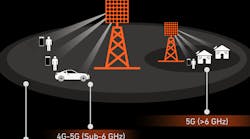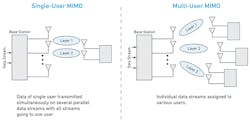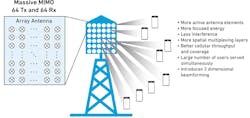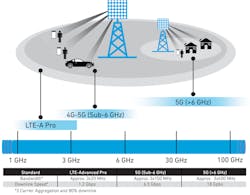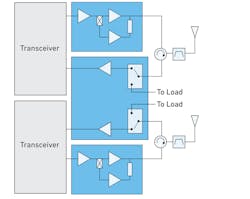Download this article in PDF format.
By 2021, it’s estimated that more people will have mobile phones (5.5 billion) than running water (5.3 billion). Bandwidth-hungry video will further increase the demands on mobile networks, accounting for 78% of mobile traffic.1 5G networks using massive multiple-input, multiple-output (MIMO) technology will be key to supporting this growth. It’s expected that 5G mobile connections will grow from just 5 million in 2019 to nearly 600 million by 2023, according to Strategy Analytics.2
MIMO: The Basics
1. Single-user MIMO systems were used for 3G, while 4G adopted multi-user MIMO system technology.
Each generation of wireless technology has used advances in antenna technology to help improve network speeds. 3G employed single-user MIMO, which leverages multiple simultaneous data streams to transmit data from the base station to a single user. Multi-user MIMO is a dominant technology in 4G systems—it assigns different data streams to different users, providing significant capacity and performance advantages over 3G (Fig. 1). 5G will introduce massive MIMO, further increasing capacity and delivering data rates up to 20 Gb/s (Fig. 2).
2. The evolution of MIMO in wireless technology generations will ultimately lead to the use of massive MIMO for 5G.
5G Massive MIMO Explained
The 5G mantra is to increase network capacity and data rates while minimizing operator expenses. Users also increasingly expect wireless data services to deliver wireline quality.
5G massive MIMO will help operators achieve these goals. It will deliver high data rates to many users, helping to increase capacity. It will support real-time multimedia services without requiring much additional spectrum. In addition, massive MIMO will reduce energy consumption by targeting signals to individual users utilizing beamforming, a technique that focuses the signal from multiple antennas into a single strong beam.
Spatial Multiplexing and Massive-MIMO Benefits
Massive-MIMO technology uses large antenna arrays (typically comprising 64 dual-polarized, but at a minimum 16, array elements) to exploit spatial multiplexing (Fig. 3). Spatial multiplexing delivers multiple parallel streams of data within the same resource block. By expanding the total number of virtual channels, it increases capacity and data rates without additional towers and spectrum.
3. Various benefits are associated with massive MIMO, such as spatial multiplexing.
In spatial multiplexing, each spatial channel carries independent information (Fig. 4). If the environmental scattering is rich enough, many independent sub-channels are created in the same allocated bandwidth, thus achieving multiplexing gains with no additional cost in bandwidth or power. The multiplexing gain is also referred to as degrees of freedom in reference to the signal space constellation; in a massive-MIMO configuration, the degrees of freedom govern the overall capacity of the system.3
4. Each channel involved in spatial multiplexing with massive MIMO carries independent information.
With massive MIMO, multiple antennas focus the transmit and receive signals into smaller regions of space, bringing huge improvements in throughput and energy efficiency. The more data streams, the greater the data rate and more efficient use of radiated power. This approach also improves link reliability. The increase in antennas means more degrees of freedom that can be spent on spatial diversity. It improves selectivity in the transmit and receive data streams and enhances interference cancellation.
Massive MIMO will provide benefits, including:
- Preventing transmission in undesired directions, alleviating interference
- Decreasing latency, allowing for faster speeds and higher reliability
- Reducing fading and drops, boosting signal-to-noise-ratio (SNR)
- Increasing spectral efficiency and high reliability
- Greater energy efficiency
5G Massive MIMO and Sub-6-GHz Deployment
It’s clear that to achieve the 5G target of 20-Gb/s data rates, it will be necessary to use millimeter-wave (mmWave) spectrum. However, several key challenges must be addressed before mmWave can truly be used for mobile communications.
While operators and original equipment manufacturers (OEMs) continue working to finalize mmWave technology, sub-6-GHz will be the go-to 5G network technology in the near term. Sub-6-GHz frequencies are suited for both rural and urban areas since the technology can deliver high data rates over long distances (Fig. 5). Operators are initially expected to deploy 5G in 3,300- to 4,200-MHz and 4,400- to 5,000-MHz frequency ranges, which will allow up to 100-MHz channel bandwidths.
5. Differences in coverage and capacity are distinct between 5G mmWave and sub-6-GHz.
Sub-6-GHz massive MIMO will solve interference problems by using a large number of antennas at the base station and will enable base stations to serve large numbers of users in urban areas. Massive MIMO also boosts peak, average, and cell-edge throughput, maximizing cost efficiency by providing the optimal balance between user coverage and capacity.
These technology advances do not come without system design challenges. Sub-6-GHz massive-MIMO beamforming technology will drive demand for small, highly efficient, cost-effective power amplifiers (PAs) that can be used in massive-MIMO arrays. Also, because the 5G modulation schemes are becoming more complex (i.e., 256 QAM), wireless infrastructure PAs will need to be very efficient under the deep output-power back-off conditions (up to 8 dB or more) that will be required to achieve the necessary linearity.
Making 5G Massive-MIMO Sub-6-GHz a Reality Using GaN
High output power, linearity, and power-consumption requirements are pushing base-station and network OEMs to switch from using LDMOS technology for PAs to gallium nitride (GaN). GaN offers numerous advantages for 5G sub-6-GHz massive-MIMO base-station applications:
- GaN performs well at 3.5-GHz frequencies and above, while LDMOS is challenged at these high frequencies.
- GaN has high breakdown voltage, high current density, high transition frequency, low on-state resistance, and low parasitic capacitance. These properties translate into high output power, wide bandwidth, and high efficiency.
- GaN in a Doherty PA configuration attains average efficiencies of 50% to 60% with 100-W output power, significantly reducing transmit power consumption.
- The high-power density of GaN PAs enables small form factors that require less printed-circuit-board (PCB) space.
- Using GaN in a Doherty PA configuration allows for the use of quad-flat no-leads (QFN) plastic packages rather than the expensive ceramic packages.
- GaN’s efficiency at high frequency and over wide bandwidths means that massive-MIMO systems can be more compact. GaN reliably runs at higher operating temperatures, meaning it can use a smaller heat sink. This enables a more compact form factor.
Meeting Sub-6-GHz RFFE Design Goals
Building the RF front end (RFFE) to support these new sub-6-GHz 5G applications will be a challenge. The RFFE is critical to the system’s power output, selectivity, and power consumption. The complexity and higher frequency range are driving the need for RFFE integration, size reductions, lower power consumption, high output power, wider bandwidth, improved linearity, and increased receiver sensitivity. In addition, there are tighter coupling requirements between the transceiver, RFFE, and antenna.
Some of the goals of the 5G sub-6-GHz RFFE, and how GaN PAs can help achieve them, include:
- Higher frequencies and increased bandwidth: 5G uses higher frequencies than 4G and requires much wider component carrier bandwidths (up to 100 MHz). GaN-on-silicon-carbide (GaN-on-SiC) Doherty PAs achieve wider bandwidths and higher power-added efficiencies (PAEs) than LDMOS at these frequencies. The higher efficiency, higher output impedance, and lower parasitic capacitance of GaN devices allow for easier wideband matching and scaling to very high output power.
- High power efficiency at higher data rates: GaN has soft compression characteristics, making it easier to pre-distort and linearize. Thus, it’s easier to use in digital pre-distortion (DPD) high-efficiency applications. GaN is able to operate across multiple cellular bands, helping network operators deploy carrier aggregation to increase spectrum and create larger data pipes for increasing network capacity.
- Minimizing system power consumption: How do we meet the high data requirements of 5G? We will need more infrastructure, such as data centers, servers, and small cells. This means an overall increase in network power consumption, thus driving the need for system efficiency and overall power savings. Ultimately, the carriers demand more for less, which might seem difficult. But again, GaN can help provide the solution by offering high output power coupled with increased efficiency in base stations.
Figure 6 shows a high-level block diagram of an example sub-6-GHz RFFE, which uses a Qorvo Doherty PA design to attain high efficiency.
6. This sub-6-GHz massive MIMO RFFE includes a Doherty PA.
GaN is becoming one of the go-to technologies for 5G. Qorvo has been manufacturing GaN for many years, and is able to quickly bring discrete and integrated modules to market. As shown in Figure 7, the company provides an array of products for greater design flexibility.
7. Qorvo offers an array of sub-6-GHz products.
Summary
5G massive-MIMO sub-6-GHz infrastructure designs are already being rolled out. This means the technology and system designs needed to address higher frequencies, higher power output, and lower power consumption must be available now to support global carrier build-out. Technologies such as GaN help carriers and base-station OEMs achieve their goals for 5G sub-6-GHz and mmWave massive MIMO.
David Schnaufer is Technical Marketing Manager and Bror Peterson is Wireless System Architect at Qorvo.
References:
1. Cisco Systems, “Mobile Visual Networking Index (VNI) Forecast Projects 7-Fold Increase in Global Mobile Data Traffic from 2016-2021.”
2. Strategy Analytics, “Strategy Analytics Forecasts Nearly 600 Million 5G Users by 2023.”
3. Gaussianwaves.com, “MIMO – Diversity and Spatial Multiplexing.”
